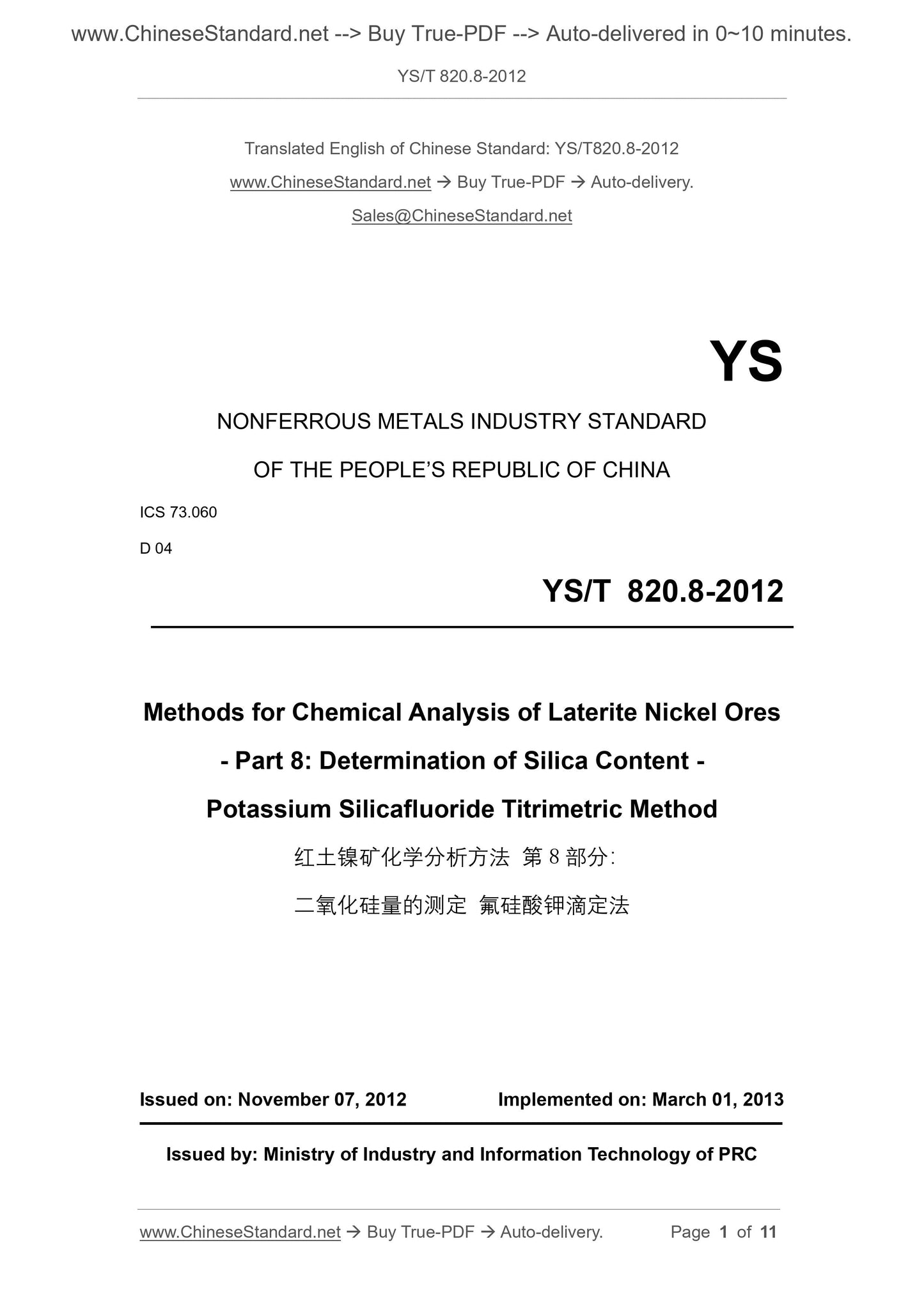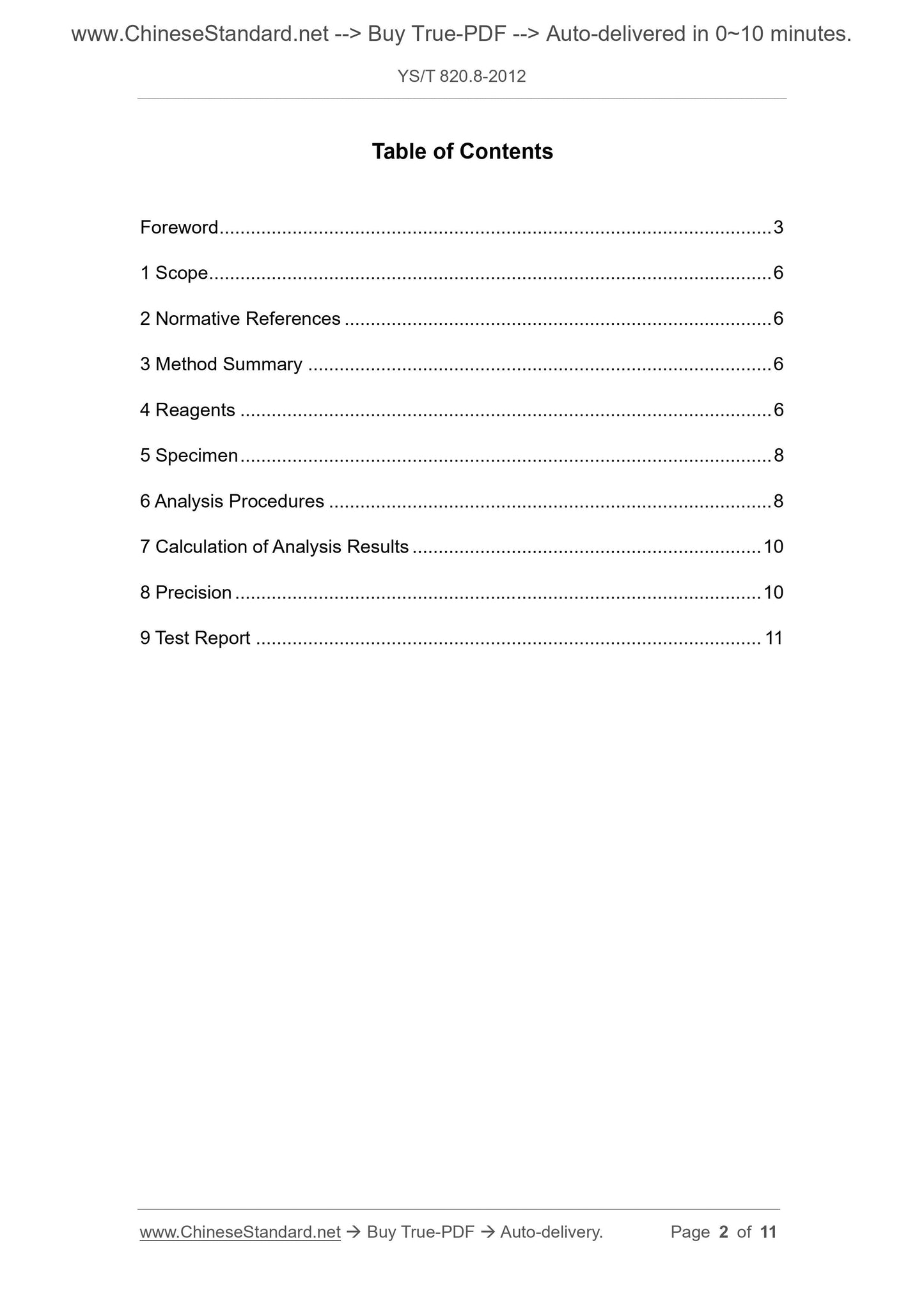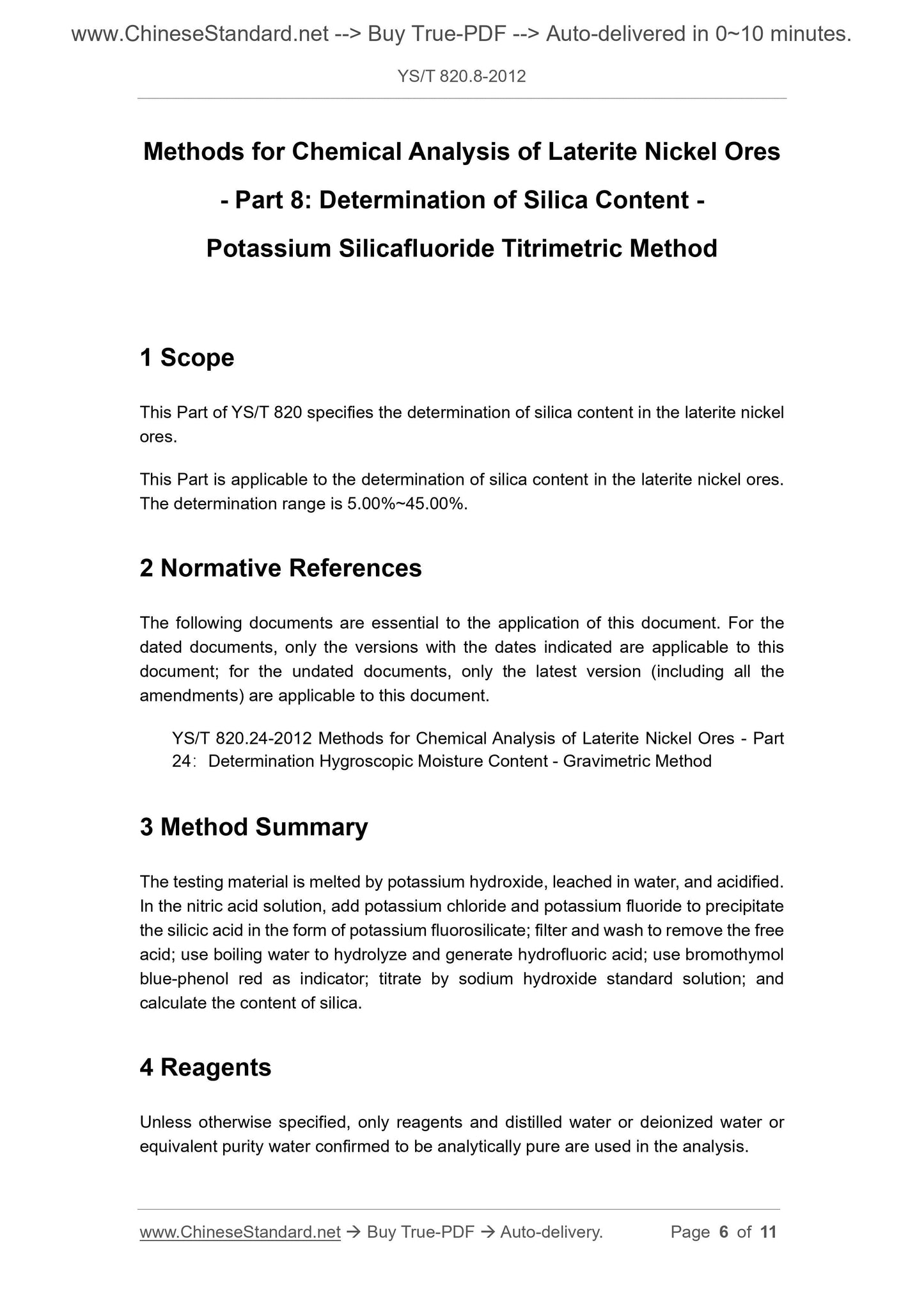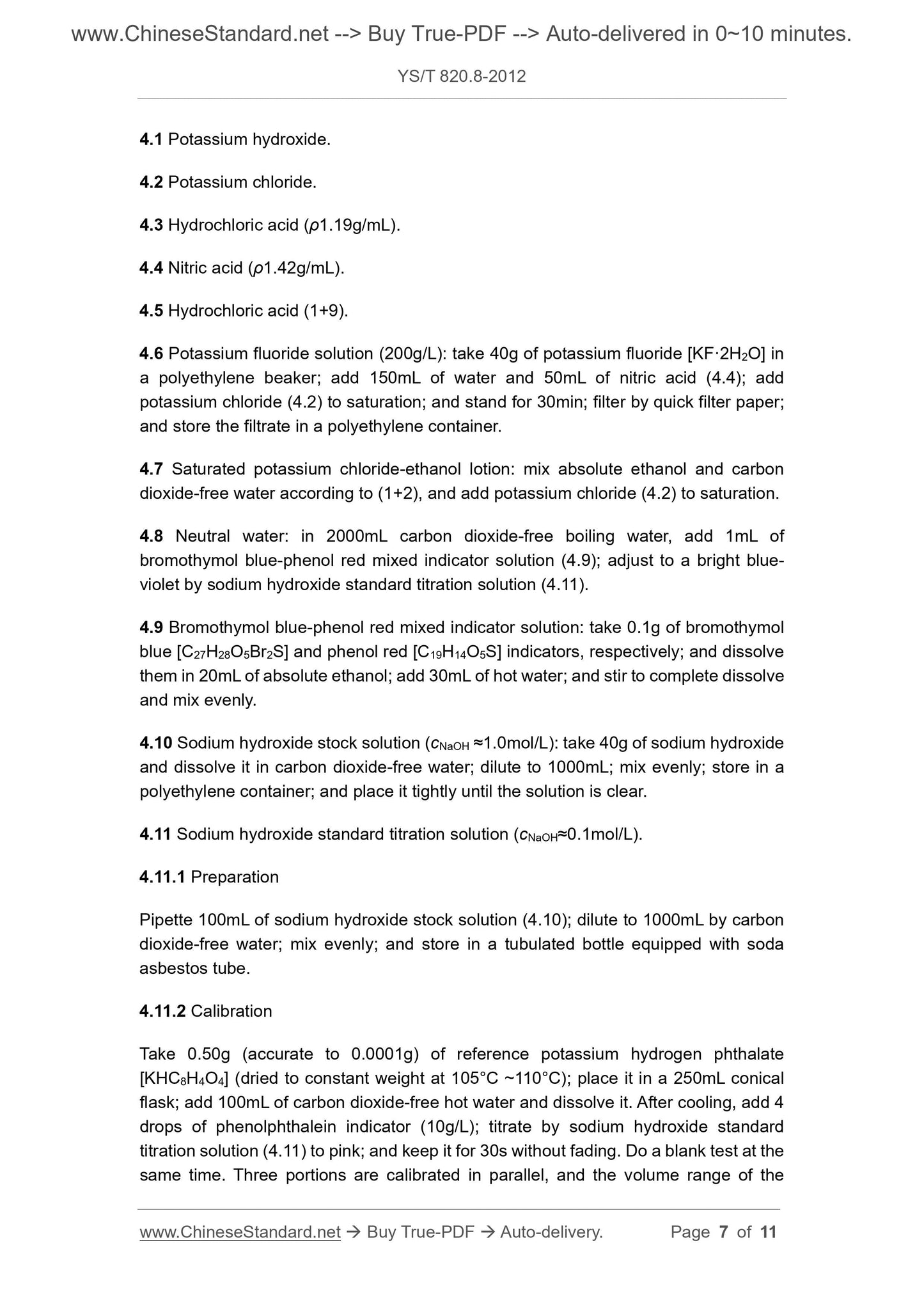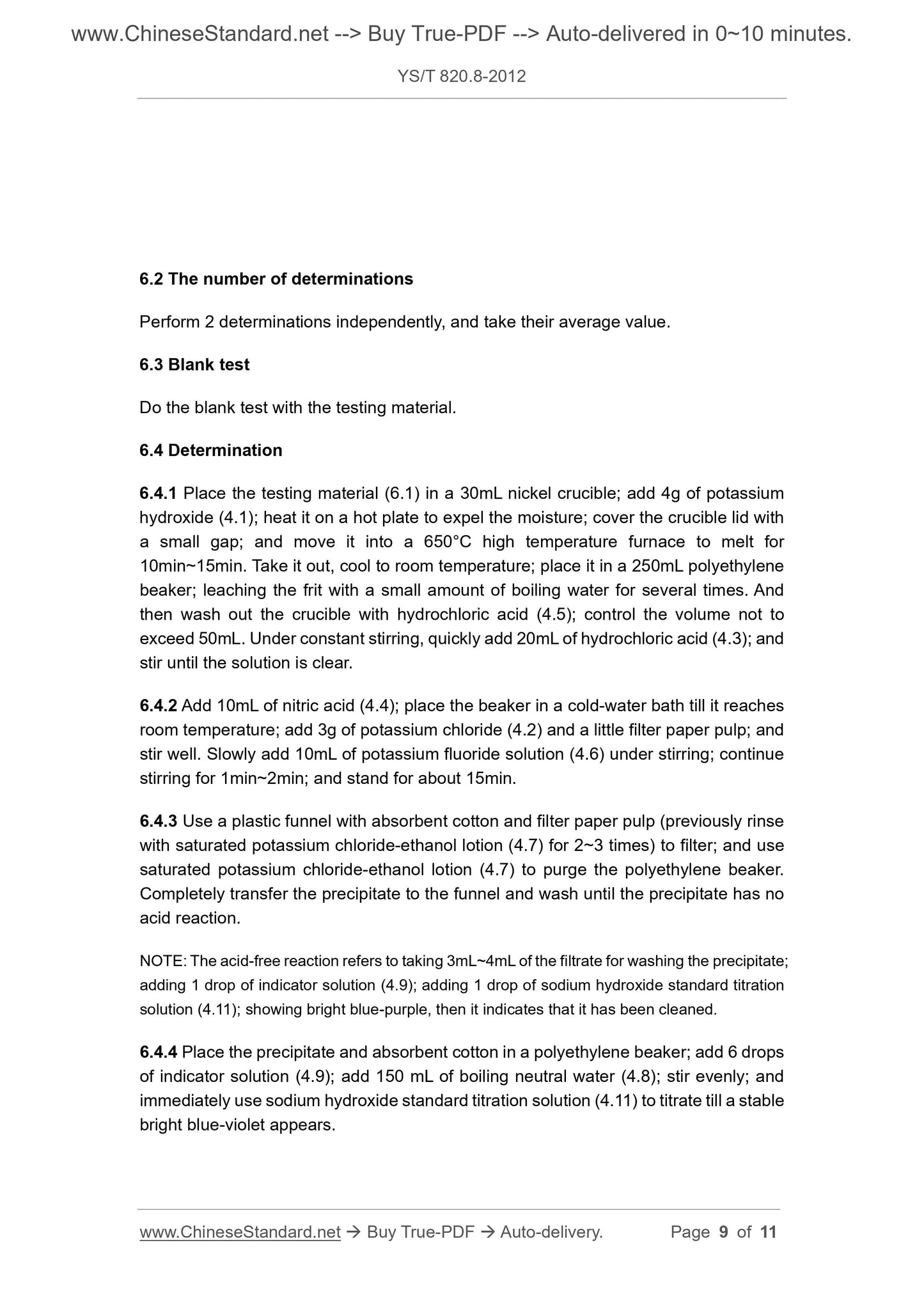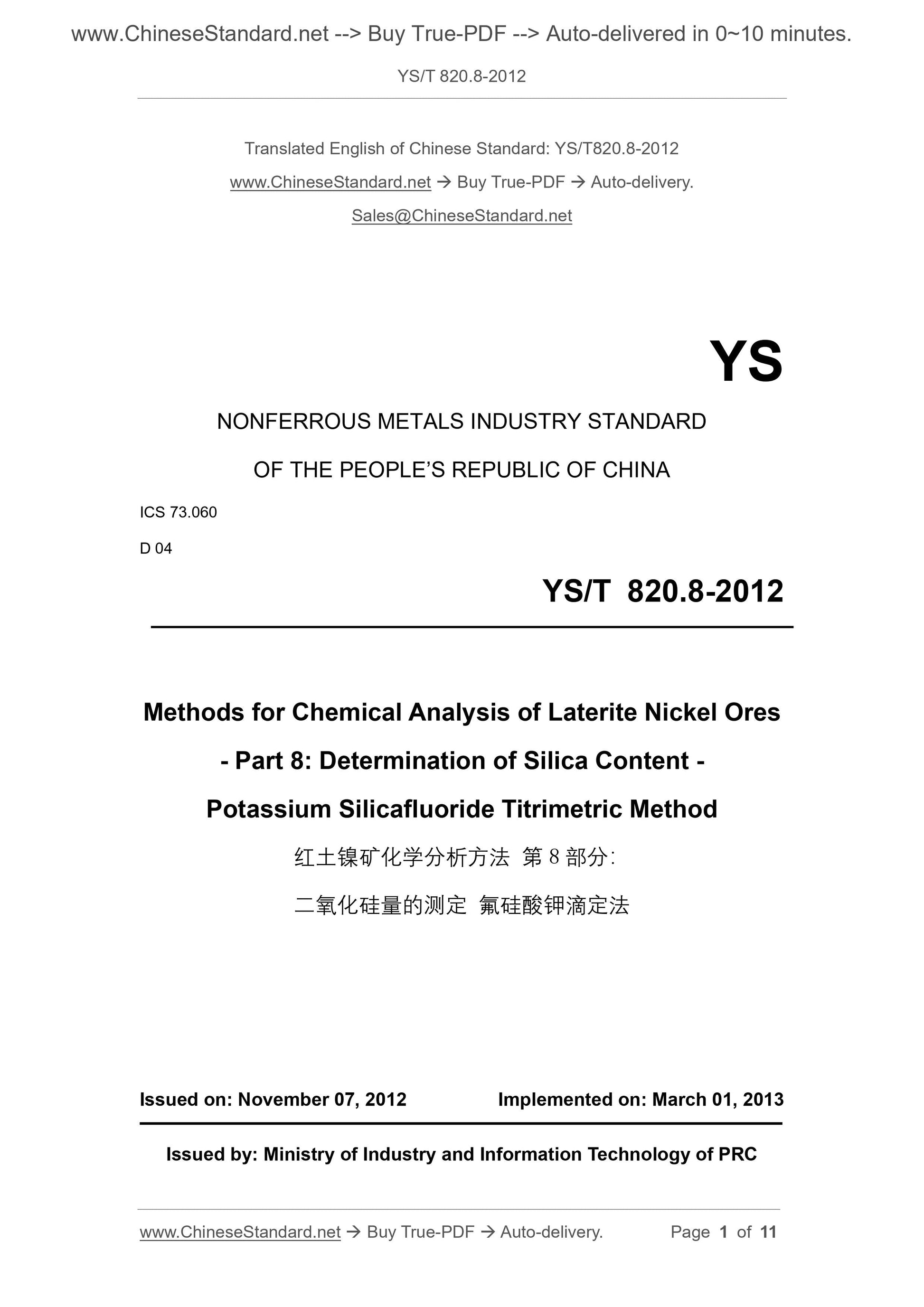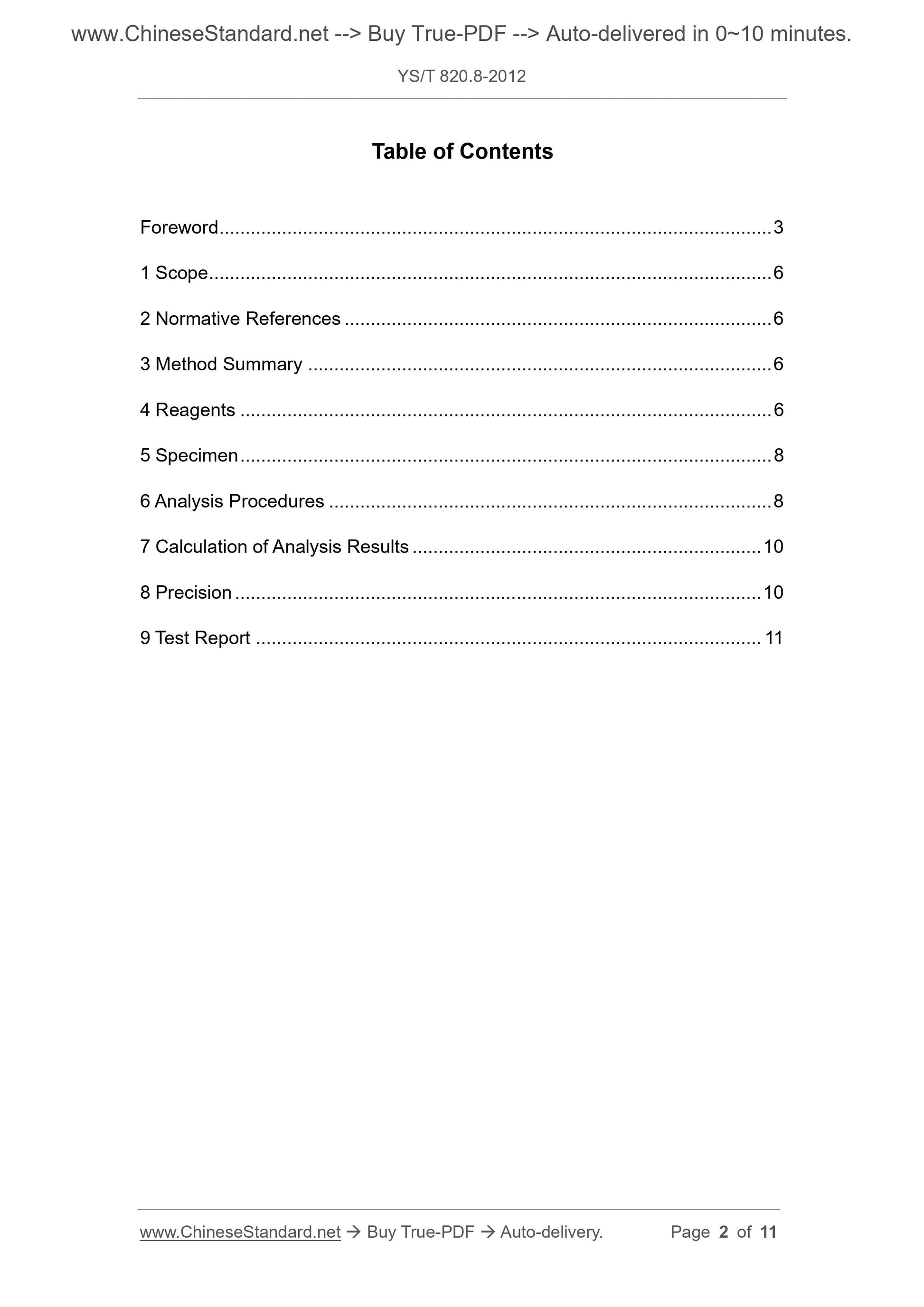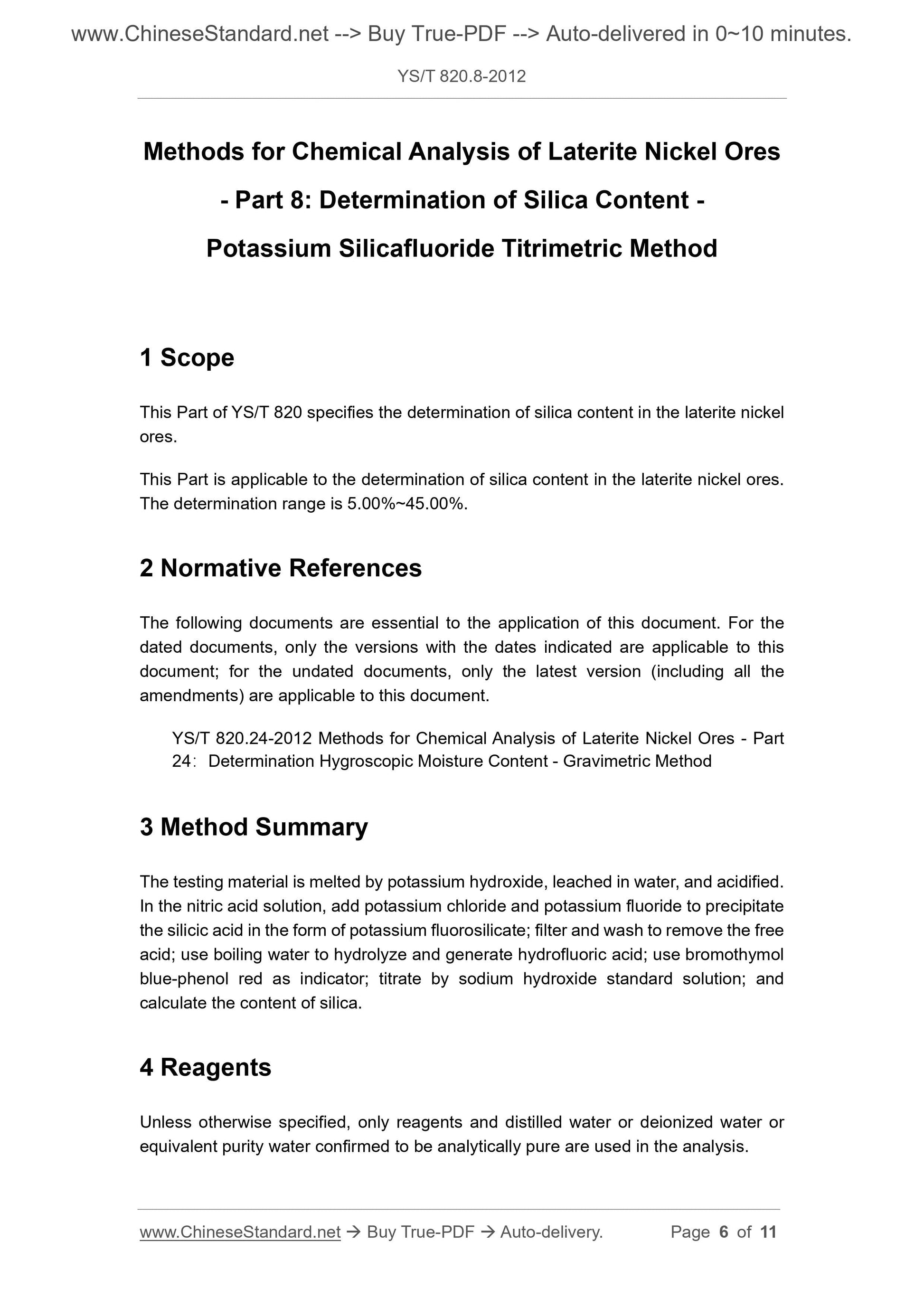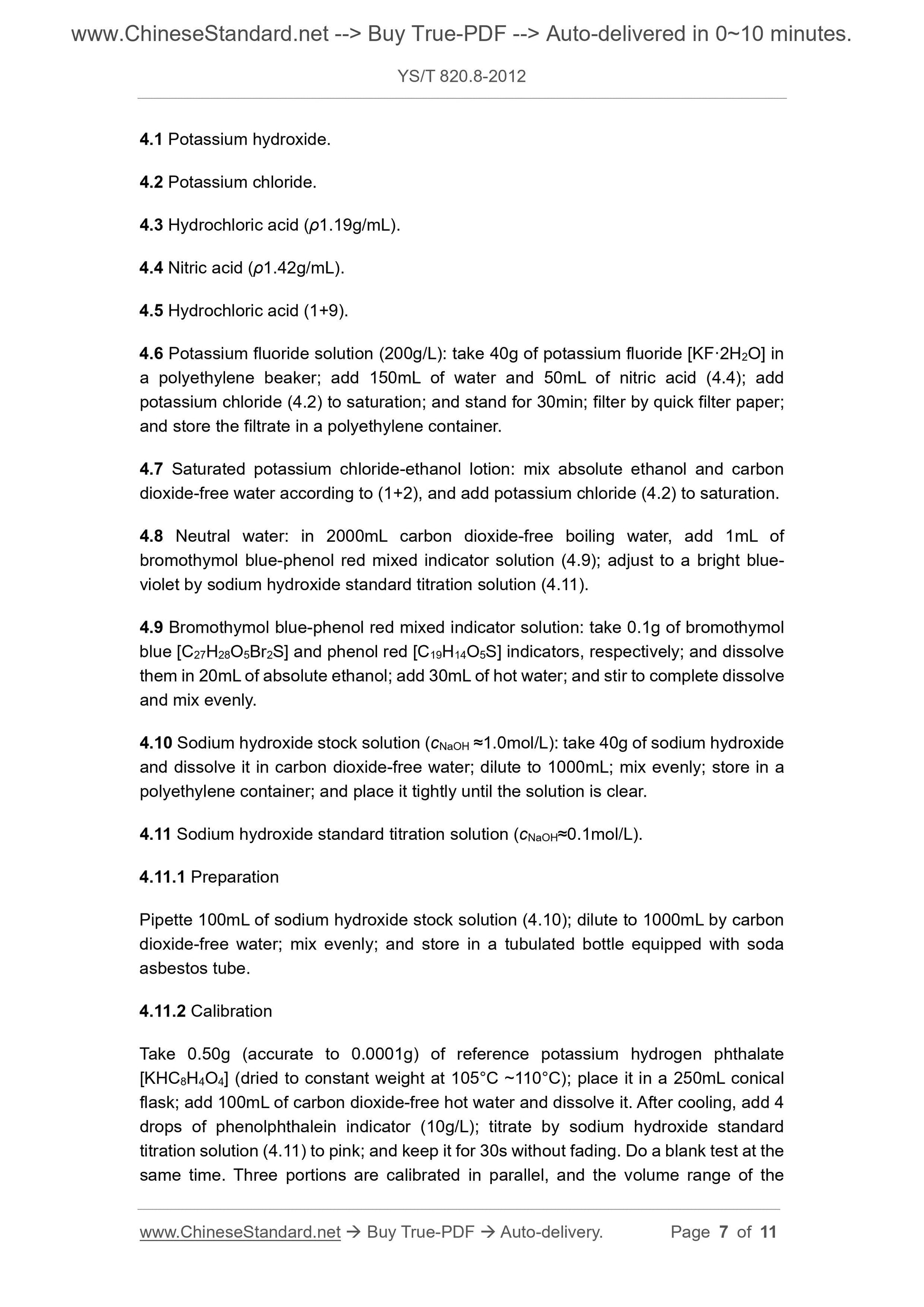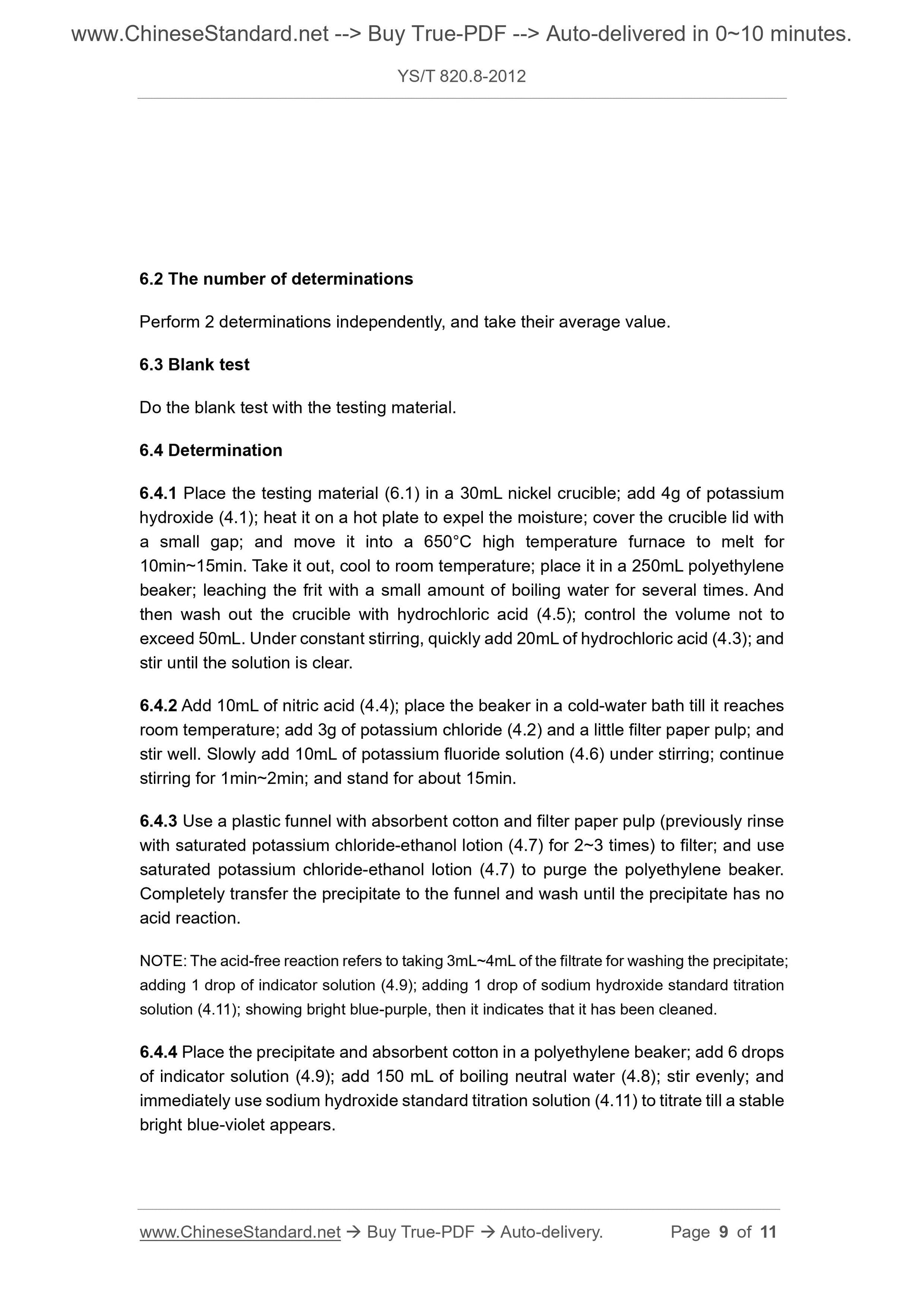1
/
su
5
PayPal, credit cards. Download editable-PDF & invoice in 1 second!
YS/T 820.8-2012 English PDF (YST820.8-2012)
YS/T 820.8-2012 English PDF (YST820.8-2012)
Prezzo di listino
$130.00 USD
Prezzo di listino
Prezzo scontato
$130.00 USD
Prezzo unitario
/
per
Spese di spedizione calcolate al check-out.
Impossibile caricare la disponibilità di ritiro
Delivery: 3 seconds. Download true-PDF + Invoice.
Get QUOTATION in 1-minute: Click YS/T 820.8-2012
Historical versions: YS/T 820.8-2012
Preview True-PDF (Reload/Scroll if blank)
YS/T 820.8-2012: Methods for chemical analysis of laterite nickel ores. Part 8: Determination of silica content. Potassium silicafluoride titrimetric method
YS/T 820.8-2012
YS
NONFERROUS METALS INDUSTRY STANDARD
OF THE PEOPLE’S REPUBLIC OF CHINA
ICS 73.060
D 04
Methods for Chemical Analysis of Laterite Nickel Ores
- Part 8: Determination of Silica Content -
Potassium Silicafluoride Titrimetric Method
ISSUED ON: NOVEMBER 07, 2012
IMPLEMENTED ON: MARCH 01, 2013
Issued by: Ministry of Industry and Information Technology of PRC
Table of Contents
Foreword ... 3
1 Scope ... 6
2 Normative References ... 6
3 Method Summary ... 6
4 Reagents ... 6
5 Specimen ... 8
6 Analysis Procedures ... 8
7 Calculation of Analysis Results ... 10
8 Precision ... 10
9 Test Report ... 11
Methods for Chemical Analysis of Laterite Nickel Ores
- Part 8: Determination of Silica Content -
Potassium Silicafluoride Titrimetric Method
1 Scope
This Part of YS/T 820 specifies the determination of silica content in the laterite nickel
ores.
This Part is applicable to the determination of silica content in the laterite nickel ores.
The determination range is 5.00%~45.00%.
2 Normative References
The following documents are essential to the application of this document. For the
dated documents, only the versions with the dates indicated are applicable to this
document; for the undated documents, only the latest version (including all the
amendments) are applicable to this document.
YS/T 820.24-2012 Methods for Chemical Analysis of Laterite Nickel Ores - Part
24: Determination Hygroscopic Moisture Content - Gravimetric Method
3 Method Summary
The testing material is melted by potassium hydroxide, leached in water, and acidified.
In the nitric acid solution, add potassium chloride and potassium fluoride to precipitate
the silicic acid in the form of potassium fluorosilicate; filter and wash to remove the free
acid; use boiling water to hydrolyze and generate hydrofluoric acid; use bromothymol
blue-phenol red as indicator; titrate by sodium hydroxide standard solution; and
calculate the content of silica.
4 Reagents
Unless otherwise specified, only reagents and distilled water or deionized water or
equivalent purity water confirmed to be analytically pure are used in the analysis.
4.1 Potassium hydroxide.
4.2 Potassium chloride.
4.3 Hydrochloric acid (ρ1.19g/mL).
4.4 Nitric acid (ρ1.42g/mL).
4.5 Hydrochloric acid (1+9).
4.6 Potassium fluoride solution (200g/L): take 40g of potassium fluoride [KF·2H2O] in
a polyethylene beaker; add 150mL of water and 50mL of nitric acid (4.4); add
potassium chloride (4.2) to saturation; and stand for 30min; filter by quick filter paper;
and store the filtrate in a polyethylene container.
4.7 Saturated potassium chloride-ethanol lotion: mix absolute ethanol and carbon
dioxide-free water according to (1+2), and add potassium chloride (4.2) to saturation.
4.8 Neutral water: in 2000mL carbon dioxide-free boiling water, add 1mL of
bromothymol blue-phenol red mixed indicator solution (4.9); adjust to a bright blue-
violet by sodium hydroxide standard titration solution (4.11).
4.9 Bromothymol blue-phenol red mixed indicator solution: take 0.1g of bromothymol
blue [C27H28O5Br2S] and phenol red [C19H14O5S] indicators, respectively; and dissolve
them in 20mL of absolute ethanol; add 30mL of hot water; and stir to complete dissolve
and mix evenly.
4.10 Sodium hydroxide stock solution (cNaOH ≈1.0mol/L): take 40g of sodium hydroxide
and dissolve it in carbon dioxide-free water; dilute to 1000mL; mix evenly; store in a
polyethylene container; and place it tightly until the solution is clear.
4.11 Sodium hydroxide standard titration solution (cNaOH≈0.1mol/L).
4.11.1 Preparation
Pipette 100mL of sodium hydroxide stock solution (4.10); dilute to 1000mL by carbon
dioxide-free water; mix evenly; and store in a tubulated bottle equipped with soda
asbestos tube.
4.11.2 Calibration
Take 0.50g (accurate to 0.0001g) of reference potassium hydrogen phthalate
[KHC8H4O4] (dried to constant weight at 105°C ~110°C); place it in a 250mL conical
flask; add 100mL of carbon dioxide-free hot water and dissolve it. After cooling, add 4
drops of phenolphthalein indicator (10g/L); titrate by sodium hydroxide standard
titration solution (4.11) to pink; and keep it for 30s without fading. Do a blank test at the
same time. Three portions are calibrated in parallel, and the volume range of the
6.2 The number of determinations
Perform 2 determinations independently, and take their average value.
6.3 Blank test
Do the blank test with the testing material.
6.4 Determination
6.4.1 Place the testing material (6.1) in a 30mL nickel crucible; add 4g of potassium
hydroxide (4.1); heat it on a hot plate to expel the moisture; cover the crucible lid with
a small gap; and move it into a 650°C high temperature furnace to melt for
10min~15min. Take it out, cool to room temperature; place it in a 250mL polyethylene
beaker; leaching the frit with a small amount of boiling water for several times. And
then wash out the crucible with hydrochloric acid (4.5); control the volume not to
exceed 50mL. Under constant stirring, quickly add 20mL of hydrochloric acid (4.3); and
stir until the solution is clear.
6.4.2 Add 10mL of nitric acid (4.4); place the beaker in a cold-water bath till it reaches
room temperature; add 3g of potassium chloride (4.2) and a little filter paper pulp; and
stir well. Slowly add 10mL of potassium fluoride solution (4.6) under stirring; continue
stirring for 1min~2min; and stand for about 15min.
6.4.3 Use a plastic funnel with absorbent cotton and filter paper pulp (previously rinse
with saturated potassium chloride-ethanol lotion (4.7) for 2~3 times) to filter; and use
saturated potassium chloride-ethanol lotion (4.7) to purge the polyethylene beaker.
Completely transfer the precipitate to the funnel and wash until the precipitate has no
acid reaction.
NOTE: The acid-free reaction refers to taking 3mL~4mL of the filtrate for washing the precipitate;
adding 1 drop of indicator solution (4.9); adding 1 drop of sodium hydroxide standard titration
solution (4.11); showing bright blue-purple, then it indicates that it has been cleaned.
6.4.4 Place the precipitate and absorbent cotton in a polyethylene beaker; add 6 drops
of indicator solution (4.9); add 150 mL of boiling neutral water (4.8); stir evenly; and
immediately use sodium hydroxide standard titration solution (4.11) to titrate till a stable
bright blue-violet appears.
Get QUOTATION in 1-minute: Click YS/T 820.8-2012
Historical versions: YS/T 820.8-2012
Preview True-PDF (Reload/Scroll if blank)
YS/T 820.8-2012: Methods for chemical analysis of laterite nickel ores. Part 8: Determination of silica content. Potassium silicafluoride titrimetric method
YS/T 820.8-2012
YS
NONFERROUS METALS INDUSTRY STANDARD
OF THE PEOPLE’S REPUBLIC OF CHINA
ICS 73.060
D 04
Methods for Chemical Analysis of Laterite Nickel Ores
- Part 8: Determination of Silica Content -
Potassium Silicafluoride Titrimetric Method
ISSUED ON: NOVEMBER 07, 2012
IMPLEMENTED ON: MARCH 01, 2013
Issued by: Ministry of Industry and Information Technology of PRC
Table of Contents
Foreword ... 3
1 Scope ... 6
2 Normative References ... 6
3 Method Summary ... 6
4 Reagents ... 6
5 Specimen ... 8
6 Analysis Procedures ... 8
7 Calculation of Analysis Results ... 10
8 Precision ... 10
9 Test Report ... 11
Methods for Chemical Analysis of Laterite Nickel Ores
- Part 8: Determination of Silica Content -
Potassium Silicafluoride Titrimetric Method
1 Scope
This Part of YS/T 820 specifies the determination of silica content in the laterite nickel
ores.
This Part is applicable to the determination of silica content in the laterite nickel ores.
The determination range is 5.00%~45.00%.
2 Normative References
The following documents are essential to the application of this document. For the
dated documents, only the versions with the dates indicated are applicable to this
document; for the undated documents, only the latest version (including all the
amendments) are applicable to this document.
YS/T 820.24-2012 Methods for Chemical Analysis of Laterite Nickel Ores - Part
24: Determination Hygroscopic Moisture Content - Gravimetric Method
3 Method Summary
The testing material is melted by potassium hydroxide, leached in water, and acidified.
In the nitric acid solution, add potassium chloride and potassium fluoride to precipitate
the silicic acid in the form of potassium fluorosilicate; filter and wash to remove the free
acid; use boiling water to hydrolyze and generate hydrofluoric acid; use bromothymol
blue-phenol red as indicator; titrate by sodium hydroxide standard solution; and
calculate the content of silica.
4 Reagents
Unless otherwise specified, only reagents and distilled water or deionized water or
equivalent purity water confirmed to be analytically pure are used in the analysis.
4.1 Potassium hydroxide.
4.2 Potassium chloride.
4.3 Hydrochloric acid (ρ1.19g/mL).
4.4 Nitric acid (ρ1.42g/mL).
4.5 Hydrochloric acid (1+9).
4.6 Potassium fluoride solution (200g/L): take 40g of potassium fluoride [KF·2H2O] in
a polyethylene beaker; add 150mL of water and 50mL of nitric acid (4.4); add
potassium chloride (4.2) to saturation; and stand for 30min; filter by quick filter paper;
and store the filtrate in a polyethylene container.
4.7 Saturated potassium chloride-ethanol lotion: mix absolute ethanol and carbon
dioxide-free water according to (1+2), and add potassium chloride (4.2) to saturation.
4.8 Neutral water: in 2000mL carbon dioxide-free boiling water, add 1mL of
bromothymol blue-phenol red mixed indicator solution (4.9); adjust to a bright blue-
violet by sodium hydroxide standard titration solution (4.11).
4.9 Bromothymol blue-phenol red mixed indicator solution: take 0.1g of bromothymol
blue [C27H28O5Br2S] and phenol red [C19H14O5S] indicators, respectively; and dissolve
them in 20mL of absolute ethanol; add 30mL of hot water; and stir to complete dissolve
and mix evenly.
4.10 Sodium hydroxide stock solution (cNaOH ≈1.0mol/L): take 40g of sodium hydroxide
and dissolve it in carbon dioxide-free water; dilute to 1000mL; mix evenly; store in a
polyethylene container; and place it tightly until the solution is clear.
4.11 Sodium hydroxide standard titration solution (cNaOH≈0.1mol/L).
4.11.1 Preparation
Pipette 100mL of sodium hydroxide stock solution (4.10); dilute to 1000mL by carbon
dioxide-free water; mix evenly; and store in a tubulated bottle equipped with soda
asbestos tube.
4.11.2 Calibration
Take 0.50g (accurate to 0.0001g) of reference potassium hydrogen phthalate
[KHC8H4O4] (dried to constant weight at 105°C ~110°C); place it in a 250mL conical
flask; add 100mL of carbon dioxide-free hot water and dissolve it. After cooling, add 4
drops of phenolphthalein indicator (10g/L); titrate by sodium hydroxide standard
titration solution (4.11) to pink; and keep it for 30s without fading. Do a blank test at the
same time. Three portions are calibrated in parallel, and the volume range of the
6.2 The number of determinations
Perform 2 determinations independently, and take their average value.
6.3 Blank test
Do the blank test with the testing material.
6.4 Determination
6.4.1 Place the testing material (6.1) in a 30mL nickel crucible; add 4g of potassium
hydroxide (4.1); heat it on a hot plate to expel the moisture; cover the crucible lid with
a small gap; and move it into a 650°C high temperature furnace to melt for
10min~15min. Take it out, cool to room temperature; place it in a 250mL polyethylene
beaker; leaching the frit with a small amount of boiling water for several times. And
then wash out the crucible with hydrochloric acid (4.5); control the volume not to
exceed 50mL. Under constant stirring, quickly add 20mL of hydrochloric acid (4.3); and
stir until the solution is clear.
6.4.2 Add 10mL of nitric acid (4.4); place the beaker in a cold-water bath till it reaches
room temperature; add 3g of potassium chloride (4.2) and a little filter paper pulp; and
stir well. Slowly add 10mL of potassium fluoride solution (4.6) under stirring; continue
stirring for 1min~2min; and stand for about 15min.
6.4.3 Use a plastic funnel with absorbent cotton and filter paper pulp (previously rinse
with saturated potassium chloride-ethanol lotion (4.7) for 2~3 times) to filter; and use
saturated potassium chloride-ethanol lotion (4.7) to purge the polyethylene beaker.
Completely transfer the precipitate to the funnel and wash until the precipitate has no
acid reaction.
NOTE: The acid-free reaction refers to taking 3mL~4mL of the filtrate for washing the precipitate;
adding 1 drop of indicator solution (4.9); adding 1 drop of sodium hydroxide standard titration
solution (4.11); showing bright blue-purple, then it indicates that it has been cleaned.
6.4.4 Place the precipitate and absorbent cotton in a polyethylene beaker; add 6 drops
of indicator solution (4.9); add 150 mL of boiling neutral water (4.8); stir evenly; and
immediately use sodium hydroxide standard titration solution (4.11) to titrate till a stable
bright blue-violet appears.
Share
